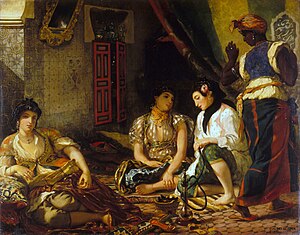Parisian Women in Algerian Costume (The Harem)
| Parisian Women in Algerian Costume (The Harem) | |
|---|---|
 | |
| Artist | Pierre-Auguste Renoir |
| Year | 1872 |
| Type | Oil on canvas |
| Dimensions | 156 cm × 129 cm (61 in × 51 in) |
| Location | National Museum of Western Art, Tokyo |

Parisian Women in Algerian Costume (The Harem) is an oil on canvas painting by Pierre-Auguste Renoir completed in 1872. It was rejected for the Paris Salon that year. It was sequestered by the French Government in 1944 but returned to Japan in 1959 where it is now in the National Museum of Western Art in Tokyo.[1]
Homage to Delacroix
In the 1870s, Renoir temporarily rejected the realism of Gustave Courbet and Eduard Manet in favour of the influence of his hero Delacroix. The Harem was painted as a homage to Delacroix's Women of Algiers in their Apartment (1834, Louvre)[1] which Renoir described as "the most beautiful picture in existence".[2] The title was chosen in order to forestall criticism that paintings of Oriental scenes were artificial by being honest about it at the start and possibly in joking reference to the fact that it was known that Delacroix had created his work in the studio using French models as he had had only brief access to women's accommodation during his trip to Algiers in 1832.[3] Roger Benjamin argues that the work is a "naturalist demythologization of the Orient" and in the nature of a pastiche.[4] It was rejected for the Salon of 1872[5] which Benjamin sees as causing the end of Renoir's experiments with Orientalism in the 1870s.[6]
Provenance
The painting was acquired by Hyacinthe-Eugène Meunier (Murer). Eugène Murer, Paris; E. Fasquelle, Paris (before 1912); Bernheim-Jeune, Paris (purchased by Eugène Fasquelle, 4 October 1913); Bernheim-Jeune fils (bought by Bernheim-Jeune, 26 January 1914); Durand-Ruel, Paris (bought by Bernheim-Jeune fils, 31 Dec. 1921); Kojiro Matsukata (bought at Durand-Ruel, 31 December 1921(?)); Sequestered by the French government, 1944; Returned to Japan, 1959.[1]
References
- ^ a b c Parisiennes in Algerian Costume or Harem. National Museum of Western Art. Retrieved 19 December 2014.
- ^ Benjamin, Roger. (2003) Renoir and Algeria. New Haven: Yale University Press, p. 19. ISBN 0300097859
- ^ Benjamin, 2003, pp. 23 & 29.
- ^ Benjamin, 2003, p. 29.
- ^ Bailey, Colin B. (1997) Renoir's Portraits: Impressions of an Age. New Haven: Yale University Press, p. 108. ISBN 0300071337
- ^ Benjamin, 2003, p. 33.
External links
![]() Media related to Paintings by Pierre-Auguste Renoir at Wikimedia Commons
Media related to Paintings by Pierre-Auguste Renoir at Wikimedia Commons
